check engine light PONTIAC VIBE 2007 Owners Manual
[x] Cancel search | Manufacturer: PONTIAC, Model Year: 2007, Model line: VIBE, Model: PONTIAC VIBE 2007Pages: 432, PDF Size: 2.54 MB
Page 158 of 432
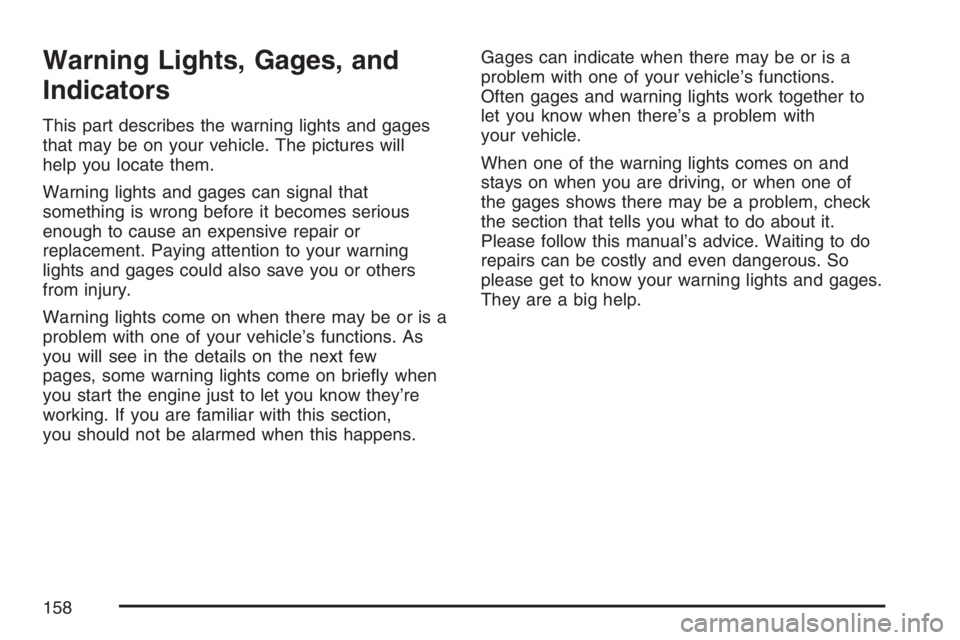
Warning Lights, Gages, and
Indicators
This part describes the warning lights and gages
that may be on your vehicle. The pictures will
help you locate them.
Warning lights and gages can signal that
something is wrong before it becomes serious
enough to cause an expensive repair or
replacement. Paying attention to your warning
lights and gages could also save you or others
from injury.
Warning lights come on when there may be or is a
problem with one of your vehicle’s functions. As
you will see in the details on the next few
pages, some warning lights come on brie�y when
you start the engine just to let you know they’re
working. If you are familiar with this section,
you should not be alarmed when this happens.Gages can indicate when there may be or is a
problem with one of your vehicle’s functions.
Often gages and warning lights work together to
let you know when there’s a problem with
your vehicle.
When one of the warning lights comes on and
stays on when you are driving, or when one of
the gages shows there may be a problem, check
the section that tells you what to do about it.
Please follow this manual’s advice. Waiting to do
repairs can be costly and even dangerous. So
please get to know your warning lights and gages.
They are a big help.
158
Page 165 of 432
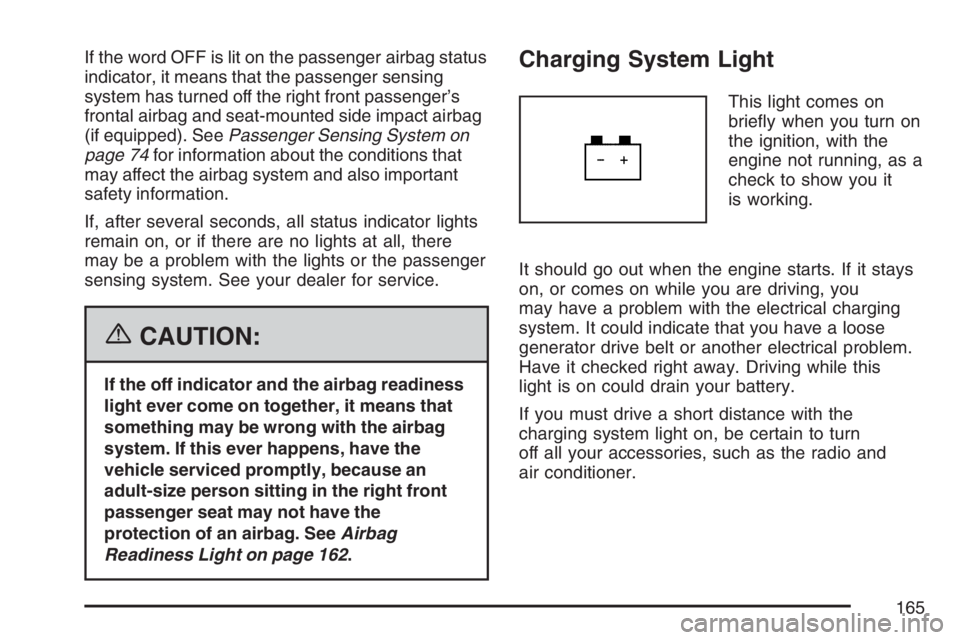
If the word OFF is lit on the passenger airbag status
indicator, it means that the passenger sensing
system has turned off the right front passenger’s
frontal airbag and seat-mounted side impact airbag
(if equipped). SeePassenger Sensing System on
page 74for information about the conditions that
may affect the airbag system and also important
safety information.
If, after several seconds, all status indicator lights
remain on, or if there are no lights at all, there
may be a problem with the lights or the passenger
sensing system. See your dealer for service.
{CAUTION:
If the off indicator and the airbag readiness
light ever come on together, it means that
something may be wrong with the airbag
system. If this ever happens, have the
vehicle serviced promptly, because an
adult-size person sitting in the right front
passenger seat may not have the
protection of an airbag. SeeAirbag
Readiness Light on page 162.
Charging System Light
This light comes on
brie�y when you turn on
the ignition, with the
engine not running, as a
check to show you it
is working.
It should go out when the engine starts. If it stays
on, or comes on while you are driving, you
may have a problem with the electrical charging
system. It could indicate that you have a loose
generator drive belt or another electrical problem.
Have it checked right away. Driving while this
light is on could drain your battery.
If you must drive a short distance with the
charging system light on, be certain to turn
off all your accessories, such as the radio and
air conditioner.
165
Page 170 of 432
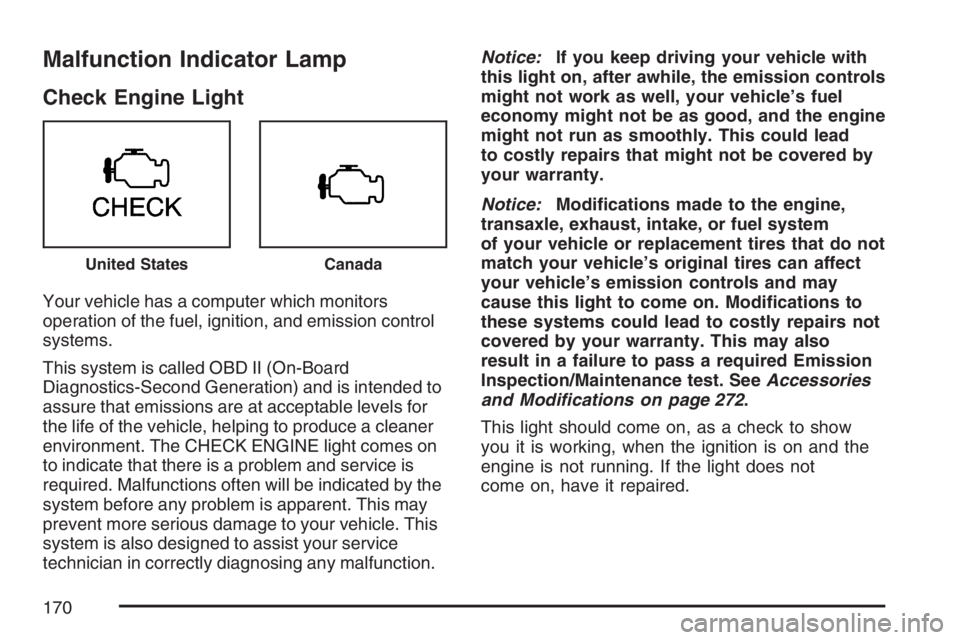
Malfunction Indicator Lamp
Check Engine Light
Your vehicle has a computer which monitors
operation of the fuel, ignition, and emission control
systems.
This system is called OBD II (On-Board
Diagnostics-Second Generation) and is intended to
assure that emissions are at acceptable levels for
the life of the vehicle, helping to produce a cleaner
environment. The CHECK ENGINE light comes on
to indicate that there is a problem and service is
required. Malfunctions often will be indicated by the
system before any problem is apparent. This may
prevent more serious damage to your vehicle. This
system is also designed to assist your service
technician in correctly diagnosing any malfunction.Notice:If you keep driving your vehicle with
this light on, after awhile, the emission controls
might not work as well, your vehicle’s fuel
economy might not be as good, and the engine
might not run as smoothly. This could lead
to costly repairs that might not be covered by
your warranty.
Notice:Modi�cations made to the engine,
transaxle, exhaust, intake, or fuel system
of your vehicle or replacement tires that do not
match your vehicle’s original tires can affect
your vehicle’s emission controls and may
cause this light to come on. Modi�cations to
these systems could lead to costly repairs not
covered by your warranty. This may also
result in a failure to pass a required Emission
Inspection/Maintenance test. SeeAccessories
and Modifications on page 272.
This light should come on, as a check to show
you it is working, when the ignition is on and the
engine is not running. If the light does not
come on, have it repaired.
United StatesCanada
170
Page 172 of 432

Did you just drive through a deep puddle of water?
If so, your electrical system may be wet. The
condition will usually be corrected when the
electrical system dries out. A few driving trips
should turn the light off.
Have you recently changed brands of fuel?
If so, be sure to fuel your vehicle with quality fuel.
SeeGasoline Octane on page 274. Poor fuel
quality will cause your engine not to run as
efficiently as designed. You may notice this as
stalling after start-up, stalling when you put
the vehicle into gear, mis�ring, hesitation on
acceleration, or stumbling on acceleration. (These
conditions may go away once the engine is
warmed up.) This will be detected by the system
and cause the light to turn on.
If you experience one or more of these conditions,
change the fuel brand you use. It will require at
least one full tank of the proper fuel to turn the
light off.
If none of the above steps have made the light
turn off, your dealer can check the vehicle.
Your dealer has the proper test equipment and
diagnostic tools to �x any mechanical or electrical
problems that may have developed.Emissions Inspection and Maintenance
Programs
Some state/provincial and local governments have
or may begin programs to inspect the emission
control equipment on your vehicle. Failure to pass
this inspection could prevent you from getting a
vehicle registration.
Here are some things you need to know to help
your vehicle pass an inspection:
Your vehicle will not pass this inspection if the
Check Engine light is on or not working properly.
Your vehicle will not pass this inspection if the OBD
(on-board diagnostic) system determines that
critical emission control systems have not been
completely diagnosed by the system. The vehicle
would be considered not ready for inspection. This
can happen if you have recently replaced your
battery or if your battery has run down. The
diagnostic system is designed to evaluate critical
emission control systems during normal driving.
This may take several days of routine driving. If you
have done this and your vehicle still does not pass
the inspection for lack of OBD system readiness,
your dealer can prepare the vehicle for inspection.
172
Page 173 of 432
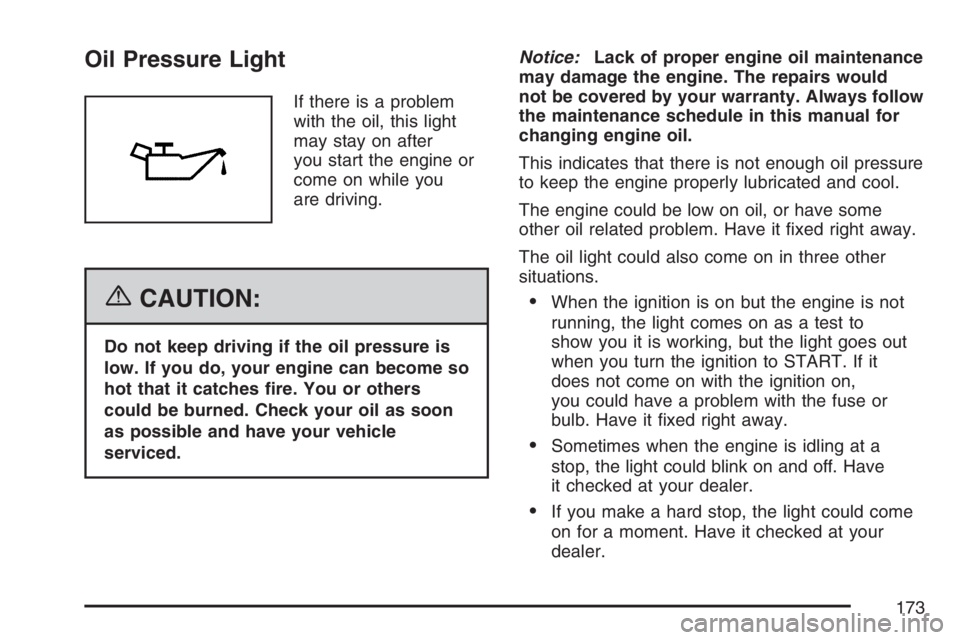
Oil Pressure Light
If there is a problem
with the oil, this light
may stay on after
you start the engine or
come on while you
are driving.
{CAUTION:
Do not keep driving if the oil pressure is
low. If you do, your engine can become so
hot that it catches �re. You or others
could be burned. Check your oil as soon
as possible and have your vehicle
serviced.Notice:Lack of proper engine oil maintenance
may damage the engine. The repairs would
not be covered by your warranty. Always follow
the maintenance schedule in this manual for
changing engine oil.
This indicates that there is not enough oil pressure
to keep the engine properly lubricated and cool.
The engine could be low on oil, or have some
other oil related problem. Have it �xed right away.
The oil light could also come on in three other
situations.
When the ignition is on but the engine is not
running, the light comes on as a test to
show you it is working, but the light goes out
when you turn the ignition to START. If it
does not come on with the ignition on,
you could have a problem with the fuse or
bulb. Have it �xed right away.
Sometimes when the engine is idling at a
stop, the light could blink on and off. Have
it checked at your dealer.
If you make a hard stop, the light could come
on for a moment. Have it checked at your
dealer.
173
Page 188 of 432

CD Messages
CHECK CD:If this message displays and/or the
CD comes out, it could be for one of the
following reasons:
It is very hot. When the temperature returns to
normal, the CD should play.
You are driving on a very rough road. When
the road becomes smoother, the CD
should play.
The CD is dirty, scratched, wet, or
upside down.
The air is very humid. If so, wait about an hour
and try again.
There could have been a problem while burning
the CD.
The label could be caught in the CD player.
If the CD is not playing correctly, for any other
reason, try a known good CD.
If any error occurs repeatedly or if an error cannot
be corrected, contact your dealer. If the radio
displays an error message, write it down
and provide it to your dealer when reporting the
problem.
Radio with CD (MP3)
The radio has a theft-deterrent feature. A red light
blinks while the engine is off to indicate the
radio is protected. It will not operate if it is installed
in a different vehicle.
188
Page 227 of 432
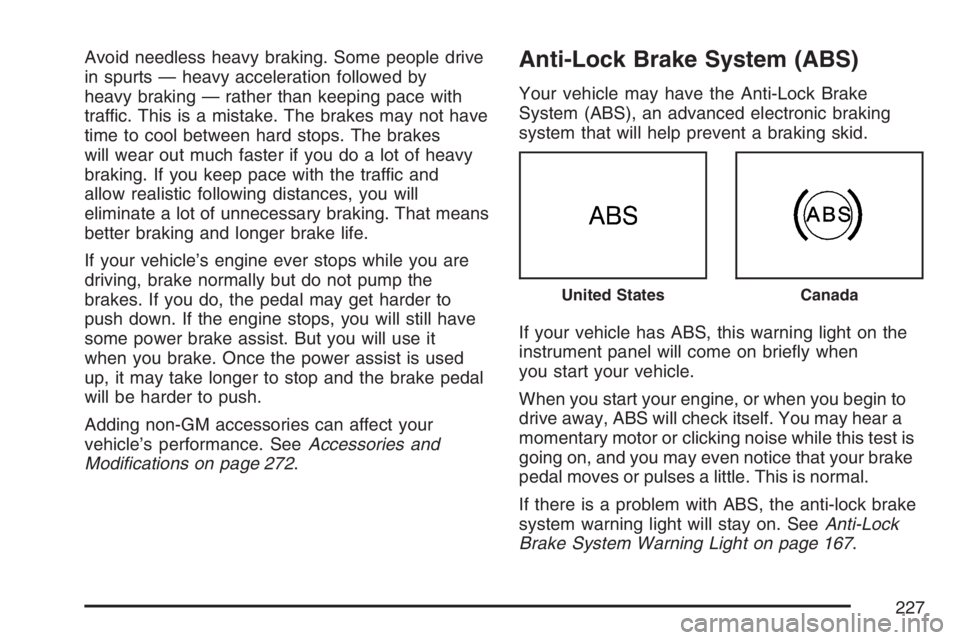
Avoid needless heavy braking. Some people drive
in spurts — heavy acceleration followed by
heavy braking — rather than keeping pace with
traffic. This is a mistake. The brakes may not have
time to cool between hard stops. The brakes
will wear out much faster if you do a lot of heavy
braking. If you keep pace with the traffic and
allow realistic following distances, you will
eliminate a lot of unnecessary braking. That means
better braking and longer brake life.
If your vehicle’s engine ever stops while you are
driving, brake normally but do not pump the
brakes. If you do, the pedal may get harder to
push down. If the engine stops, you will still have
some power brake assist. But you will use it
when you brake. Once the power assist is used
up, it may take longer to stop and the brake pedal
will be harder to push.
Adding non-GM accessories can affect your
vehicle’s performance. SeeAccessories and
Modi�cations on page 272.Anti-Lock Brake System (ABS)
Your vehicle may have the Anti-Lock Brake
System (ABS), an advanced electronic braking
system that will help prevent a braking skid.
If your vehicle has ABS, this warning light on the
instrument panel will come on brie�y when
you start your vehicle.
When you start your engine, or when you begin to
drive away, ABS will check itself. You may hear a
momentary motor or clicking noise while this test is
going on, and you may even notice that your brake
pedal moves or pulses a little. This is normal.
If there is a problem with ABS, the anti-lock brake
system warning light will stay on. SeeAnti-Lock
Brake System Warning Light on page 167.
United StatesCanada
227
Page 231 of 432
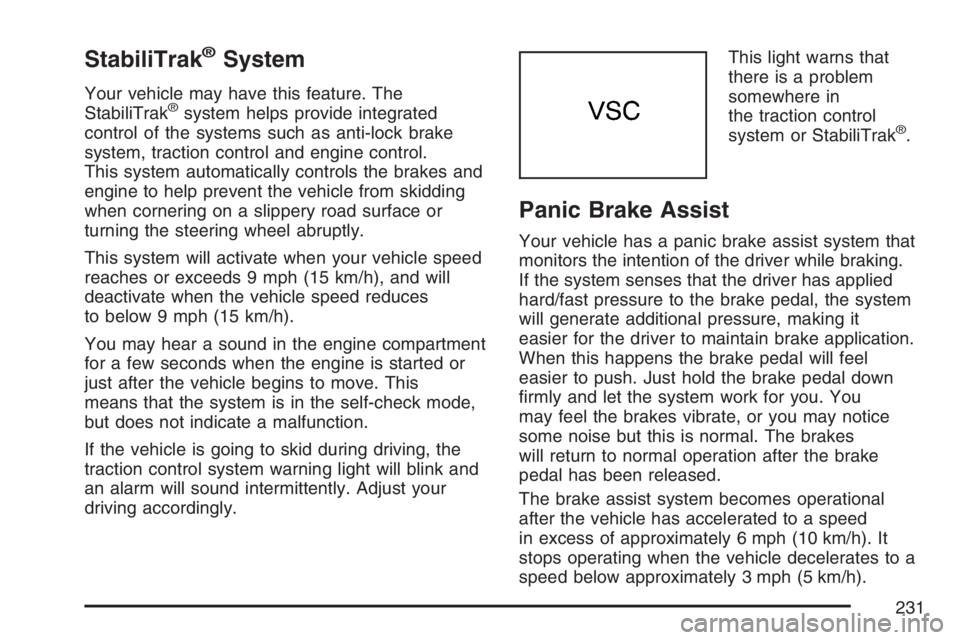
StabiliTrak®System
Your vehicle may have this feature. The
StabiliTrak®system helps provide integrated
control of the systems such as anti-lock brake
system, traction control and engine control.
This system automatically controls the brakes and
engine to help prevent the vehicle from skidding
when cornering on a slippery road surface or
turning the steering wheel abruptly.
This system will activate when your vehicle speed
reaches or exceeds 9 mph (15 km/h), and will
deactivate when the vehicle speed reduces
to below 9 mph (15 km/h).
You may hear a sound in the engine compartment
for a few seconds when the engine is started or
just after the vehicle begins to move. This
means that the system is in the self-check mode,
but does not indicate a malfunction.
If the vehicle is going to skid during driving, the
traction control system warning light will blink and
an alarm will sound intermittently. Adjust your
driving accordingly.This light warns that
there is a problem
somewhere in
the traction control
system or StabiliTrak®.
Panic Brake Assist
Your vehicle has a panic brake assist system that
monitors the intention of the driver while braking.
If the system senses that the driver has applied
hard/fast pressure to the brake pedal, the system
will generate additional pressure, making it
easier for the driver to maintain brake application.
When this happens the brake pedal will feel
easier to push. Just hold the brake pedal down
�rmly and let the system work for you. You
may feel the brakes vibrate, or you may notice
some noise but this is normal. The brakes
will return to normal operation after the brake
pedal has been released.
The brake assist system becomes operational
after the vehicle has accelerated to a speed
in excess of approximately 6 mph (10 km/h). It
stops operating when the vehicle decelerates to a
speed below approximately 3 mph (5 km/h).
231
Page 251 of 432
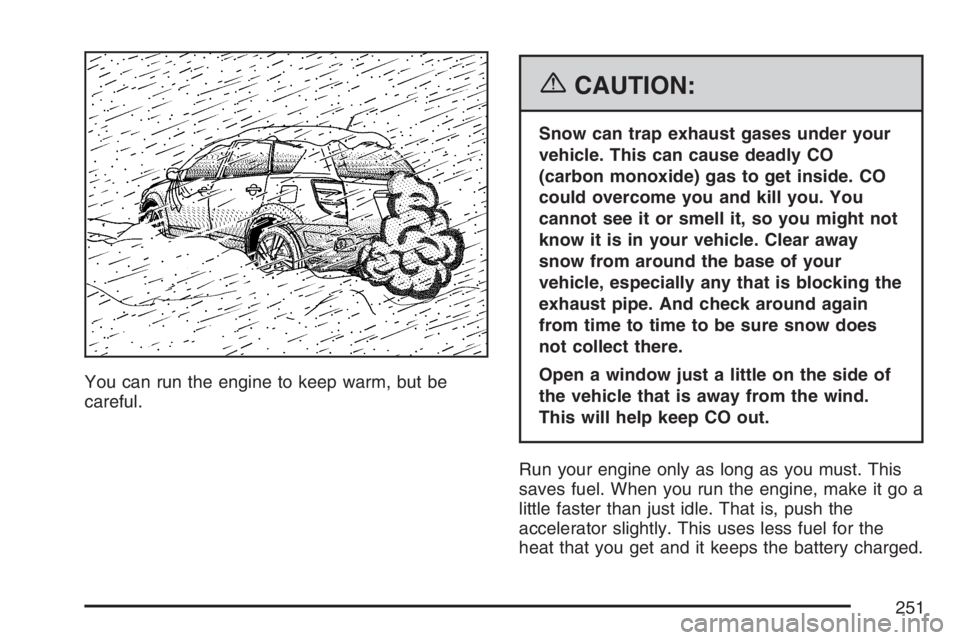
You can run the engine to keep warm, but be
careful.
{CAUTION:
Snow can trap exhaust gases under your
vehicle. This can cause deadly CO
(carbon monoxide) gas to get inside. CO
could overcome you and kill you. You
cannot see it or smell it, so you might not
know it is in your vehicle. Clear away
snow from around the base of your
vehicle, especially any that is blocking the
exhaust pipe. And check around again
from time to time to be sure snow does
not collect there.
Open a window just a little on the side of
the vehicle that is away from the wind.
This will help keep CO out.
Run your engine only as long as you must. This
saves fuel. When you run the engine, make it go a
little faster than just idle. That is, push the
accelerator slightly. This uses less fuel for the
heat that you get and it keeps the battery charged.
251
Page 284 of 432

Engine Oil
If the engine oil
pressure light appears
on the instrument
cluster, check the
engine oil level
right away.
For more information, seeOil Pressure Light on
page 173. You should check the engine oil
level regularly; this is an added reminder.
Checking Engine Oil
It is a good idea to check the engine oil every time
you get fuel. In order to get an accurate reading,
the oil must be warm and the vehicle must be
on level ground.
The engine oil dipstick handle is a yellow loop.
SeeEngine Compartment Overview on page 282
for the location of the engine oil dipstick.
1. Turn off the engine and give the oil several
minutes to drain back into the oil pan. If you
do not do this, the oil dipstick might not
show the actual level.
2. Pull out the dipstick and clean it with a paper
towel or cloth, then push it back in all the
way. Remove it again, keeping the tip down,
and check the level.
284